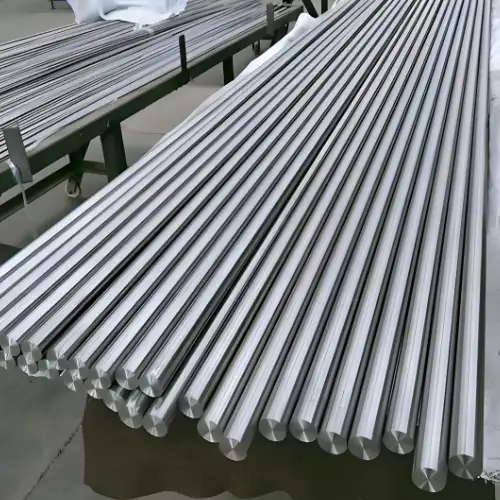As of mid-2025 Monel® K-500 finished material typically trades in the range USD 30–70 per kg (depending on form: bar/rod, sheet/plate, pipe, or powder; and on order size, mill test certificates and surface finish). For small orders and finished components expect the high end of that band; for larger FOB factory orders from China the lower end is realistic. For engineering procurement, treat the alloy’s raw-metal value (nickel + copper fractions) as the baseline and add fabrication, heat-treatment and alloy premium.
What is Monel K-500
Monel® K-500 (UNS N05500, W.Nr. 2.4375) is a precipitation-hardening nickel-copper alloy that combines the corrosion resistance of Monel 400 with substantially higher strength produced by additions of aluminum and titanium and controlled heat treatment. Typical composition is roughly ~63–66% Ni, 27–31% Cu, 2–3% Al (plus Ti and trace elements); it is covered by industry specs such as ASTM B865 / ASME SB-865, AMS 4676 for certain products and forms. Mechanical properties after age-hardening include much higher yield and tensile strength than Monel 400, making K-500 the common choice for high-strength marine, oil & gas, and downhole components.
Why price matters
-
Raw materials set the floor. Because K-500 contains ~65% nickel and ~30% copper, movements in nickel and copper prices explain most of the baseline cost. Use LME / market nickel and copper as starting points.
-
Form, processing and certification create the delta. Bars, plate, welded tubes, powder and finished machined components require different processing (hot-working, cold-drawing, aging, machining, NDT, plating) — each step adds $/kg.
How vendors calculate a price per kg (simple, reproducible method)
A transparent buyer approach is:
-
Calculate raw metal content cost (per kg)
K-500_raw ≈ Ni_fraction × Ni_price_per_kg + Cu_fraction × Cu_price_per_kg + minor_elements_cost -
Add conversion + alloy premium (processing, scrap losses, heat treatment, finishing)
Typical conversion + premium = USD 10–45/kg depending on quantity, documentation (3.1/3.2), and fabrication. -
Add freight/insurance and local taxes (if CIF/CFR).
Worked example (rounded): using mid-2025 spot levels (~Ni = USD 15,000/tonne → USD 15/kg; Cu = USD 9,500/tonne → USD 9.5/kg), and Ni_fraction 0.65, Cu_fraction 0.295:
-
raw metal value ≈ 0.65×15 + 0.295×9.5 ≈ 9.75 + 2.80 ≈ USD 12.55/kg
-
add conversion/premium (say USD 20/kg for small orders) → USD ~32.5/kg
This matches many current FOB price listings for commercial K-500 forms.
Five-year market price summary (indicative averages)
Method note: Monel K-500 is not a single exchange-traded metal — it’s priced by suppliers. The table below uses supplier price reports and converts commodity averages (nickel, copper) plus observed market premiums to produce consistent year-by-year reference midpoints. These are approximate market averages (USD/kg) for common wrought forms (bars/rounds, commercial small-lot FOB). Use them as procurement benchmarks, not firm quotes.
| Year | Indicative average (USD / kg, common small-lot market) | Comments |
|---|---|---|
| 2021 | 28–38 | Post-pandemic rebound; nickel higher than 2020. |
| 2022 | 35–55 | Volatility from supply shocks and LME mechanics pushed nickel up in parts of 2022. |
| 2023 | 45–75 | Elevated levels in several markets because of supply tightness and logistical premiums. |
| 2024 | 40–60 | Prices eased as Indonesian NPI and expanded refining relieved tightness; regional variance high. |
| 2025 (mid) | 30–70 | Wide spread: small orders, quick delivery and full test certificates at top of band; factory FOB large orders near lower band. Sources show active vendor ranges consistent with this band. |

2025 — Global price
These are representative mid-2025 market ranges expressed in USD / kg for commonly traded product forms (FOB or ex-works where indicated). Exact price depends on quantity, MTC, certification and finish.
-
China (FOB Shenzhen, factory lot ≥500 kg): USD 28–38 / kg (bars/sheets).
-
India (domestic stock/fast delivery): USD 30–75 / kg (wide spread; many traders list USD 20–75/kg depending on form and MTC).
-
USA / Europe (distributor stock, small lots): USD 45–95 / kg (distributors add inventory & handling premium).
-
Middle East (import CIF, project lots): USD 35–80 / kg (project specifications and inspection add cost).
-
Powder / AM feedstock (specialty, small batches): USD 80–250 / kg depending on particle size and certification.
Buyer takeaway: factory direct (China) for bulk material is typically the most cost-effective path if the supplier can provide the required MTCs and export documentation.
Price by product form (what costs more and why)
-
Bars / Rods (hot-rolled, bright): Lower conversion cost per kg; common cheapest form per kg.
-
Plate / Sheet: Additional rolling and levelling — small premium vs bars.
-
Seamless pipe / fittings / flanges: Higher due to workflow and testing, plus wall thickness control.
-
Welded fabrications & finished components: Highest cost — machining allowances, age-hardening, NDT, passivation and assembly time.
-
Powders (AM): Specialized atomization and sieving drives much higher cost per kg.
Key factors that influence Monel K-500 price
-
Nickel market price: The dominant driver — ~65% of alloy value is nickel. See LME / global nickel indices.
-
Copper price movement: Copper contributes ~30% and swings matter when copper moves sharply.
-
Supply chain geography: Indonesian NPI policy, Chinese processing capacity, and port congestion affect availability. Recent Indonesian expansion has had a big impact on nickel availability and pricing.
-
Form and processing: Age-hardening (precipitation heat treatment), specialized machining and NDT add cost.
-
Certification and testing: DNV, BV, EN 10204 3.1/3.2, AMS specs increase cost.
-
Order size & lead time: MOQ and lead time are key — small rush orders attract a premium.
-
Scrap & recycling flows: Availability of nickel-copper scrap reduces raw cost pressure. Market scrap quotes (Fastmarkets, regional brokers) feed pricing.
Procurement and inspection checklist (what to insist on)
-
Specify exact UNS / designation:
UNS N05500(Monel K-500) and required spec (ASTM B865 / ASME SB-865 / AMS 4676). -
MTC grade: Accept 3.1 or 3.2 certificates for critical applications.
-
Heat-treatment record: Age-hardening parameters and hardness (typical hardness range should be included).
-
Chemical analysis report: %Ni, %Cu, %Al, %Ti and trace elements.
-
Non-destructive tests: As required by purchase order (UT, PMI, dye penetrant).
-
Surface finish and dimensional tolerances: For machined components, specify form tolerance and surface finish (Ra).
-
Sample / witness testing: For large or critical orders, arrange factory witness tests or third-party inspection.
-
Packaging & export: Sea-worthy wooden crates, rust inhibitors, and proper documentation for customs clearance.
-
Lead time & penalties: Fix lead time and penalties for late delivery for project contracts.
Choosing a supplier — why MWAlloys (how to evaluate)
If you’re sourcing K-500 in bulk and want lower landed cost without sacrificing quality, consider vendors who offer:
-
Factory pricing (ex-works) and flexible MOQ — reduces per-kg cost.
-
Full documentation (EN 10204 3.1/3.2, heat-treat chart).
-
Custom processing — cutting, age-hardening cycles, machining to print.
-
Export experience — DDP/CIF options, consolidation, and ability to support project QA.
MWAlloys (China): positioned as a manufacturer & exporter that can offer factory ex-works pricing, custom heat-treat and finishing, and international shipping for project volumes. If you need, MWAlloys can provide initial sample lots with full MTCs and arrange third-party inspection prior to shipment.
Risk factors and mitigation
-
Price volatility: Hedge by fixing forward contracts or negotiating staggered deliveries. For multi-year projects ask for price-fix windows or index-linked clauses.
-
Supply-chain concentration: Diversify suppliers (China + European distributors) for critical spares.
-
Quality fraud: Always require third-party testing or stringent MTCs. Use PMI or lab certificates when necessary.
-
Regulatory & export controls: Check dual-use and export rules; certain destinations need additional checks.
Future outlook — 5 to 10 year perspective
-
Near term (1–3 years): Nickel supply remains strongly influenced by Indonesian NPI and Chinese processing. Oversupply or planned capacity increases may cap price upside; geopolitical or production outages (e.g., in Russia / New Caledonia) can spike prices. USGS and industry reports expect some moderation from 2024 highs but uncertainty remains.
-
Medium term (3–6 years): EV battery demand will continue to shape nickel fundamentals (high-nickel chemistries increase demand for refined nickel). However, K-500 is mostly affected by refined nickel availability and cost; any long-term structural deficit in high-grade nickel will push alloy premiums higher.
-
Long term (6–10 years): Innovation in recycling, HPAL and hydromet technologies may create new supply routes and potentially stabilize prices. Strategic stockpiles and industrial policy (e.g., “green premium”) can alter regional cost curves. Buyers should build multi-year supply strategies with flexible sourcing.
Practical negotiation tips (how to lower delivered $/kg)
-
Buy larger lots and consolidate shipments.
-
Accept factory (EXW/FOB) terms when you have logistics capability.
-
Standardize certificates: agree on a standard MTC scope so suppliers don’t overcharge for additional paperwork.
-
Use local third-party inspectors only for critical lots — full-time auditors raise cost; sample inspection reduces supplier margins.
-
Ask for a breakdown: request the seller’s cost build-up (raw metal + processing + premium + freight) — many will provide a range.
FAQs
-
Q: Is Monel K-500 more expensive than Monel 400?
A: Yes — K-500 carries an alloy and processing premium for age-hardening and added elements; expect a material premium above Monel 400 of roughly 10–40% depending on market conditions. -
Q: How much nickel content is in K-500?
A: Approximately ~63–66% nickel (balance mostly copper, plus Al/Ti). -
Q: Do suppliers charge extra for age-hardening?
A: Yes — heat-treatment and controlled ageing add cost, and the supplier must show heat-treatment records. -
Q: What minimum order quantity (MOQ) should I expect?
A: MOQs vary: Chinese factories often allow 15–500 kg for small fabricated items but larger lots (500+ kg) yield better per-kg prices. -
Q: Can Monel K-500 be welded?
A: It can be welded but requires proper pre/post-weld heat treatment to avoid loss of properties; welding is more complex than for monel 400. -
Q: Is there a standard price index for Monel K-500?
A: No universal exchange index exists specifically for K-500; buyers reference nickel and copper indices plus regional supplier indices (chemanalyst, Fastmarkets). -
Q: Is powder additive manufacturing feedstock cost-effective?
A: For small complex parts, powder can be justified despite a high per-kg cost; for bulk components, wrought products remain far cheaper. -
Q: How much premium should I budget for documentation (3.1/3.2)?
A: Budget USD 2–8/kg extra for rigorous third-party certifications, depending on quantity. -
Q: What shipping incoterm lowers overall landed cost?
A: FOB or EXW factory pricing often gives the lowest per-kg price; but CIF/DDP can be more convenient and lower logistical risk depending on buyer capability. -
Q: Who owns the “Monel” trademark and where to find official alloy data?
A: Special Metals Corporation owns the MONEL® trademark; their technical bulletin for K-500 is the authoritative product datasheet.
Quick sample procurement checklist
-
Material: Monel K-500 (UNS N05500)
-
Spec: ASTM B865 / ASME SB-865 / AMS 4676 (as applicable)
-
Form: bar / plate / pipe / powder — specify dimensions & tolerances
-
Qty: ____ kg (specify)
-
MTC: EN 10204 3.1 / 3.2 (required?)
-
Heat treatment: age-hardening record required? yes/no
-
Inspection: PMI / UT / Dimensional / Hardness — specify sample rate
-
Packing & docs: Export packing, MTC, CO, commercial invoice, B/L
-
Delivery term: FOB / CIF / DDP (specify)
-
Lead time: ____ weeks
-
Payment: TT 30% / 70% before shipment or LC — negotiate
Final recommendation (for MWAlloys buyers)
For project procurement of Monel K-500 where price and traceability matter, request factory quotes (FOB China) from experienced producers such as MWAlloys, insist on EN 10204 3.1/3.2 certificates and sample heat-treatment reports, and compare those ex-works prices to local distributors (which are convenient but often 20–60% more expensive per kg). For long-term programs, negotiate index-linked pricing and stagger deliveries to smooth supplier margins.

